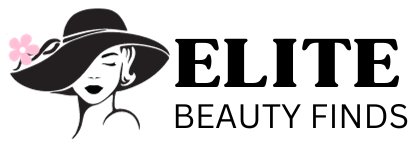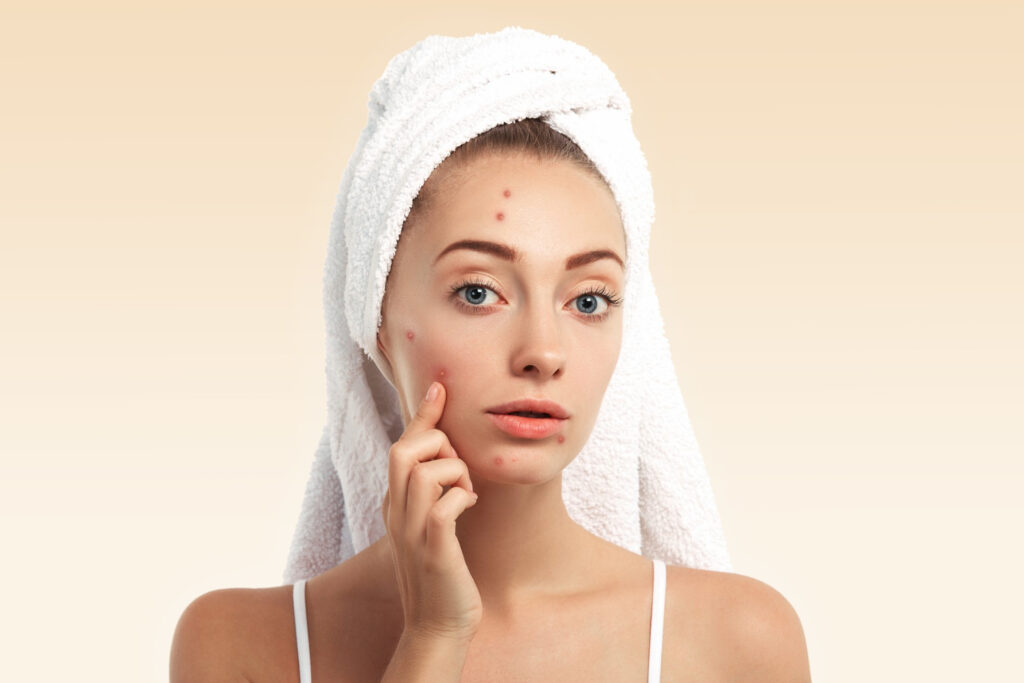Acne, a prevalent skin condition encountered by most individuals at some juncture in their lives, manifests as the emergence of blemishes, excess oiliness, and occasionally, skin sensitivity or discomfort upon contact. Primarily afflicting regions such as the face, back, and chest, acne arises when skin pores become obstructed by a combination of oil, dead cells, or bacteria. Each pore connects to a follicle housing a hair and a sebaceous gland responsible for secreting sebum, an oily substance crucial for skin hydration and suppleness. Any disruption in this sebum production process can precipitate their development.
While acne can manifest across various body areas, it predominantly targets the facial and neck regions, along with the shoulders, back, and chest. The skin’s pores, miniature apertures susceptible to blockage by oil, bacteria, dead cells, and impurities, are pivotal in their formation, leading to the formation of pimples or other imperfections.
Affecting an estimated 80% of individuals aged 11 to 30 in varying degrees, acne primarily plagues teenagers and young adults undergoing hormonal shifts. Nonetheless, its occurrence isn’t exclusive to this demographic, as adults, particularly women, can also experience its onset. Additionally, individuals with a familial predisposition to acne are at heightened risk of its development, a factor attributed to genetic influences.
What causes acne?
Acne primarily arises due to the activation of sebaceous glands triggered by hormonal surges during puberty. These hormones, originating from the adrenal glands in both genders, prompt an increase in oil production, leading to pore blockages and subsequent acne formation.
The presentation of acne varies, encompassing blackheads, whiteheads, papules, pustules, nodules, and cysts, contingent upon the nature of pore obstruction and inflammation severity. Factors such as hormonal fluctuations, genetic predisposition, and specific environmental influences contribute to the onset and exacerbation of acne.
Although stress itself doesn’t directly induce acne, it can aggravate existing conditions by intensifying its symptoms. Other triggers or exacerbators of acne include hormonal shifts in midlife, particularly notable in women, certain pharmaceuticals, and dietary factors.
Contrary to common assumptions, consumables like chocolate, oily foods, hygiene practices, and cosmetics wield minimal influence on acne development. Instead, adopting a balanced diet, adhering to proper skincare routines, and addressing underlying hormonal irregularities are pivotal to their management and prevention.
Treatment
Treatment for acne falls into two main categories: topical and oral medications, with the selection depending on the acne’s severity.
Topical remedies comprise several options:
- Benzoyl peroxide acts as an antiseptic, reducing surface bacteria, diminishing whiteheads and blackheads, and providing anti-inflammatory effects. It’s available as a cream or gel, typically applied once or twice daily, adjusted for skin sensitivity.
- Topical retinoids, like tretinoin and adapalene, prevent hair follicle blockages and are applied in the evening, gradually increasing in frequency to minimize sun sensitivity.
- Antibiotics, such as clindamycin or erythromycin with benzoyl peroxide, combat excess skin bacteria and inflammation, often combined with benzoyl peroxide to mitigate antibiotic resistance.
- Azelaic acid and salicylic acid offer antibacterial and follicle-clearing properties, with azelaic acid proving effective in pregnancy and while breastfeeding.
Oral medications encompass:
- Antibiotics are typically the initial choice for moderate-to-severe acne, reducing bacteria and inflammation. They should be used briefly to prevent resistance, often paired with benzoyl peroxide.
- Combined oral contraceptives, approved by the FDA for acne therapy in women seeking contraception, regulate testosterone levels.
- Isotretinoin is reserved for severe, unresponsive acne due to its potent effects and potential side effects.
- Hormonal therapies, like anti-androgen therapy, target acne in women, particularly deep nodules on the lower face and neck.
It’s crucial to acknowledge that treatment requires patience, often taking months for visible improvement. Additionally, sun protection is vital with certain medications to mitigate increased sun sensitivity.
In conjunction with medication, lifestyle adjustments such as a balanced diet, regular exercise, and proper skincare can aid in managing and preventing acne. Consulting a healthcare provider or dermatologist is essential to tailoring a treatment plan to individual needs.
Read also: Rosacea: Understanding, Treatment, and Management Strategies
Natural remedies to get rid of acne
Various natural remedies exist to assist in managing and alleviating acne symptoms. Among the effective options highlighted in available sources are:
- Tea Tree Oil: Renowned for its natural antibacterial and anti-inflammatory properties, tea tree oil aids in eradicating acne-causing bacteria while reducing inflammation and redness associated with pimples.
- Apple Cider Vinegar: Exhibiting antibacterial attributes, apple cider vinegar can potentially eliminate acne-causing bacteria and diminish scar visibility.
- Aloe Vera: Serving as a natural antibacterial and anti-inflammatory agent, aloe vera aids in diminishing acne appearance and thwarting breakout occurrences.
- Zinc: With its anti-inflammatory characteristics, zinc aids in lessening acne lesions and redness. It is available in supplement form or incorporated into ointments and creams.
- Green Tea: Rich in antioxidants, green tea mitigates sebum production, which is particularly beneficial for acne-prone skin.
- Honey: Boasting antimicrobial effects and antioxidants, honey assists in unclogging pores and treating acne and related skin conditions.
- Argan Oil: Noncomedogenic in nature, argan oil balances sebum production on oily skin while nourishing dry skin.
- Jojoba Oil: Containing compounds that diminish skin inflammation, jojoba oil alleviates redness and swelling surrounding pimples and inflamed lesions.
These natural remedies complement a comprehensive acne treatment plan, although consulting a healthcare provider or dermatologist is essential, particularly for severe or persistent cases. Furthermore, conducting a patch test before adopting any new natural remedy is imperative to ascertain its compatibility and minimize the risk of irritation or adverse reactions.
It’s different types
Acne can be delineated into two principal categories: non-inflammatory and inflammatory types.
Non-inflammatory encompasses blackheads and whiteheads, typically milder and amenable to over-the-counter remedies. Blackheads, visible on the skin’s surface, are laden with excess oil and dead cells, while whiteheads, closed at the surface, similarly harbor oil and dead cells.
Conversely, inflammation presents greater severity, incorporating papules, pustules, nodules, and cysts. Papules, small reddish bumps, may exhibit tenderness, whereas pustules, akin to papules but featuring a white center indicative of pus accumulation, often manifest soreness. Nodules, sizable and inflamed, form deep within the skin and can induce discomfort, while cysts represent the most severe acne manifestation, characterized by large, pus-filled protuberances akin to boils, posing a heightened risk of scarring.
Furthermore, acne can be stratified based on its severity, with mild cases involving limited whiteheads, blackheads, or inflamed bumps, moderate instances comprising a higher count of these lesions, and severe cases marked by the presence of numerous inflamed cysts and nodules, often leading to scarring.
Notably, acne’s etiology spans diverse factors such as genetics, hormonal fluctuations, medication usage, and environmental influences. Consultation with a dermatologist for an accurate diagnosis and tailored treatment is imperative to effectively manage acne, mitigate scarring, and prevent recurrence.
Chin acne
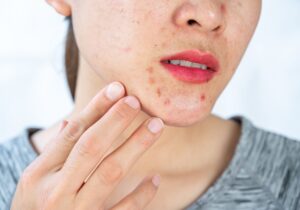
Chin acne, a prevalent skin issue, can stem from various factors like genetics, hormonal imbalances, and environmental influences. Hormonal chin acne, commonly observed in women over 25, arises from slight increases in testosterone levels, leading to heightened sebum production and pore blockages.
Addressing chin acne involves a diligent skincare regimen encompassing makeup removal, moisturizing, and sun protection. Chemical exfoliants such as salicylic acid and benzoyl peroxide aid in unclogging pores and eliminating excess oil and dead cells. Additionally, topical retinoids like adapalene expedite skin renewal, reducing the risk of pore blockages.
For hormonal acne management, oral contraceptives or patches may be prescribed, along with spot treatments combining benzoyl peroxide and topical antibiotics. Preventive measures include nightly facial cleansing with gentle products and the avoidance of pore-clogging cosmetics.
Should at-home remedies prove ineffective, consulting a dermatologist for prescription-strength treatments like antibiotics or retinoids is advisable. While diet doesn’t directly cause chin acne, maintaining a healthy lifestyle and steering clear of inflammatory triggers can enhance skin health.
Forehead acne
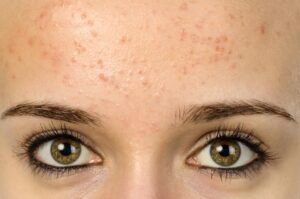
Forehead acne results from pores becoming clogged with oil, dead skin cells, and bacteria, causing inflammation. Excessive oil production, influenced by genetics and hormones, can be exacerbated by stress, systemic ailments, and dietary habits. Mechanical factors like headgear and unwashed pillowcases can also trap sweat and sebum, fostering zits. Moreover, hair products rich in oils and waxes may contribute to pore blockage.
Over-the-counter treatments such as benzoyl peroxide, salicylic acid, and adapalene combat forehead acne by eliminating bacteria, preventing breakouts, and reducing inflammation. It’s important to avoid combining benzoyl peroxide with strong chemical exfoliants or retinoids to prevent excessive dryness.
Maintaining good hygiene, refraining from touching or picking at acne, and using medicated cleansers containing salicylic acid or benzoyl peroxide twice daily are essential practices. Opting for non-comedogenic, oil-free skincare and hair products can further aid in preventing pore congestion.
For severe or persistent cases, consulting a dermatologist is advisable. Prescription-strength treatments such as topical or oral antibiotics, retinoids, or hormonal therapies may be recommended.
Back acne
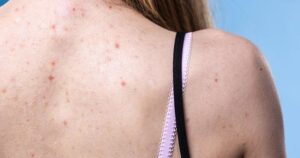
Back acne, commonly referred to as ‘bacne,’ manifests when a combination of sweat, oil, dead skin cells, and bacteria becomes ensnared in the pores along the back. Resultant pimples may appear as red bumps, whiteheads, or blackheads. Aggravating factors such as friction from clothing, sports gear, or perspiration-soaked garments can exacerbate the condition. Treatment options range from maintaining cleanliness to utilizing acne-targeting skincare products and exploring both over-the-counter and prescription remedies. Incorporating lifestyle adjustments such as post-workout showers, opting for loose attire, and integrating solutions like tea tree oil can effectively manage and prevent bacne.
Nodular acne
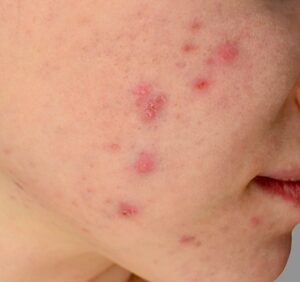
Nodular acne, also termed nodulocystic acne, is a severe form of the condition marked by nodules and cysts, often leading to scarring. Primarily affecting the face and upper trunk, it can persist into adulthood if left untreated. While typically seen in adolescence and early adulthood, a rare juvenile form may emerge before the age of six. Its complex pathogenesis involves factors like heightened sebaceous gland activity, abnormal follicle keratinization, microbial influence, and ensuing inflammation. Oral isotretinoin is the recommended treatment to prevent scarring, with additional options including oral antibiotics and systemic corticosteroids for severe cases. Consulting a dermatologist is crucial for accurate diagnosis and effective management.
Acne patches
These patches, including hydrocolloid patches, are small adhesive covers applied directly to open pimples to aid in skin healing. Constructed from materials such as polyurethane film, they feature an outer layer shielding the skin from bacteria, while an inner layer absorbs fluids like pus. The moisture generated by the hydrocolloid gel fosters healing and guards against infection, creating an optimal environment for recovery. These patches, designed for extended wear as per label instructions, create a moist milieu conducive to healing and are often more efficacious than conventional coverings. They work by absorbing infected pus and facilitating skin restoration.
Hydrocolloid Acne Patch for Face available at amazon
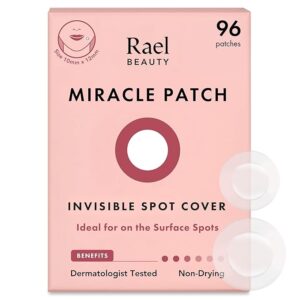
Product Details:
- Effective Care: Expertly formulated to gently draw out pus and impurities directly from the source using medical-grade hydrocolloid. Non-drying and hypoallergenic, available in two sizes (10mm and 12mm).
- Invisible Coverage: Boasting a clear, matte finish and an ultra-thin outer edge, it seamlessly blends with all skin tones for discreet use.
- Long-lasting Adherence: Tapered edges ensure patches stay securely attached to the skin, providing reliable coverage throughout the day and night.
- Skin Protection: Acts as a protective barrier against irritants, safeguarding skin health and integrity.
- Vegan and cruelty-free: committed to ethical standards, with no animal-derived ingredients and no animal testing involved in the production process.
Cerave acne foaming cream cleanser
The CeraVe Acne Foaming Cream Cleanser, endorsed by dermatologists, is crafted to efficiently dissolve dirt and excess oil while combating acne with 4% benzoyl peroxide. Infused with three essential ceramides, it fortifies the skin barrier for optimal health. Designed to deeply cleanse, prevent blemishes, and maintain skin integrity without causing dryness, it also features hyaluronic acid to preserve natural moisture and niacinamide for soothing and healing benefits. Formulated in collaboration with dermatologists, this acne-fighting cleanser suits acne-prone skin and is recommended for daily use, one to two times daily, for effective acne management.
CeraVe Acne Foaming Cream Cleanser available at Amazon
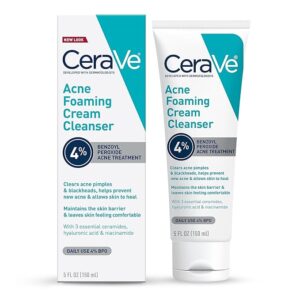
Product Description:
- This acne face wash containing benzoyl peroxide targets acne, pimples, whiteheads, and blackheads while preventing new breakouts and promoting skin healing. The product is non-sealed.
- Transitioning from a cream cleanser to a foaming texture upon application, this CeraVe face wash gently removes dirt and excess oil without stripping skin moisture.
- With hyaluronic acid for hydration and niacinamide for calming properties, this acne wash is fragrance-free and non-comedogenic.
- Infused with three essential ceramides, crucial for maintaining the skin barrier, this product supports skin health and resilience.
- All CeraVe products are FSA and HSA eligible, ensuring accessibility and affordability for users.
Acne scar treatment
Acne scarring presents a significant concern for many individuals, with treatment options ranging from at-home remedies to medical interventions administered by healthcare professionals. At-home approaches may involve using over-the-counter scar treatments or makeup to conceal scars, along with maintaining good skincare practices to prevent future breakouts. Medical treatments encompass procedures such as scar removal, skin resurfacing, fillers, and microneedling.
Surgical options like cryosurgery or electrodesiccation may be necessary for severe cases, potentially requiring skin grafts. Recognizing that not all scars are treatable is essential, and achieving optimal results may require a combination of treatments. Consulting a healthcare provider is crucial to discuss potential side effects or risks before proceeding with any medical procedures.

